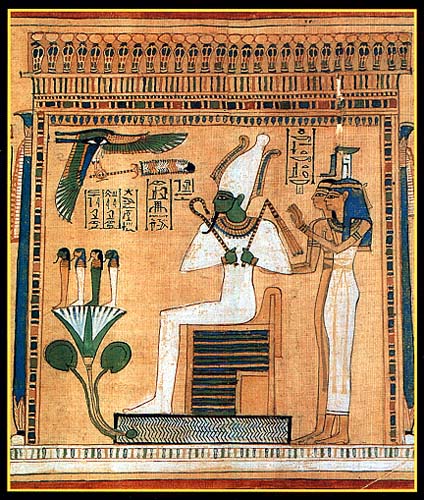 Deciphering Your Divine Family
Deciphering Your Divine Family
 Deciphering Your Divine Family
Deciphering Your Divine Family
Some Egyptian Pagans and Kemetics look to a specific god or goddess as their spiritual Parent, perhaps reflecting the Wiccan influence of God-Goddess duality. But what if you're drawn to more than one or two deities? What if you feel there are several Egyptian deities, or notjeru, in your life? In that case, you may have a link to a specific area or tradition of the Egyptian pantheon. Exploring which combinations of notjeru you work with best can help you decipher which tradition best fits your needs.
For example: If you feel drawn to Mut or Sakhmet as one of your chosen goddesses, and the male deities you feel most comfortable with include Amun-Ra, then you probably fit with the Theban tradition. If you feel positively toward Seth, that eliminates the Abydene tradition but suggests you might feel more at home in the Theban or Memphite tradition. If you feel close to Isis and Osiris, and uncomfortably towards Seth, you probably have an affinity for the Abydene or Busirite traditions. If Elder Horus is the aspect of that god you work best with, you might be at home in the Edfu or Ombite traditions. If Ra is prominent in your own worship, you might be drawn to the Heliopolitan tradition. And so on. Keep in mind, though, that some deities work well in several different traditions: Anubis was honored in Thebes as well as Abydos, as was Djehuty (Thoth). Below are some possible combinations:
Heliopolitan (based in Heliopolis,
a.k.a. On or Iunu)
- Known for the 'Heliopolitan Ennead': Ra, Shu, Tefnut, Geb, Nut, Osiris, Isis,
Seth and Nephthys
- Hathor is frequently the consort of Ra
- Ra, as either himself or Atum, is the Creator
Memphite (based in Memphis)
- Ptah is Creator, consort is Sakhmet; children are Nefertum, deified Imhotep
- Ra is connected to Nefertum
- God of the Underworld is Sokar
- tradition is "Seth-friendly"; Seth is seen as storm god rather than
chaotic figure
Abydene (based in Abydos)
- Ra is creator, Heliopolitan Ennead is honored; but Osiris and Isis take prominence
- Children of Osiris and Isis include Horus, Wepwawet (who is linked with Horus
as "Defender of His Father") and Anubis
- NOT a "Seth-friendly" tradition; Seth is seen as murderer of Osiris
Theban (based in Thebes)
- Amun or Amun-Ra is creator, consort is Mut or Mut-Sakhmet; child is Khonsu,
the moon god
- Other Memphite gods are honored, such as Ptah and Sokar
- Hathor is regarded as Lady of the Western Valley
- generally "Seth-friendly" tradition
Hermopolitan (based in Hermopolis,
a.k.a. Ashmunein or Khemnu)
- Amun and Amaunet are Creators
- Thoth (Djehuty) plays prominent role in Creation; consort is Ma'at, Seshat
or lion-goddess Nehmetawai
- Amun links with Ra; consort is Mut or Hathor
- links to Theban tradition
Saite (based in Sais)
- Neith is Creator goddess, no consort; children are Ra, Sobek or Elder Horus
(see Edfu)
Edfu (based in Edfu)
- Horus takes on Elder Horus (Hor-Ur) aspect; is son of Ra
- Horus' consort is Hathor; children are Ihy and/or Horus-SemaTawy (Harsomtus)
- NOT "Seth-friendly" tradition; combining with Abydene tradition,
annual Feast of Victory commemorates defeat of Seth as enemy of Ra and Horus
as well as Osiris
Ombite (based in Ombos,
or Nubet)
- Sobek and Seth are prominent gods, as is Elder Horus; viewed as enemies who
reconcile
- Elder Horus's consort is Hathor; Seth's may be Anate and Astarte or Tawret
Elephantine (based in Elephantine)
- Khnum, linked with Ra, is Creator; consorts are Anukit or Renenutet, a cobra
goddess, child is Satis, goddess of the river and the hunt
- Neith also worshipped; annual feast commemorated her taking the form of Mehet-Weret,
the primeval cow goddess, to save Ra from the crocodiles
Bubastite (based in Bubastis)
- Ra is Creator, consort is Bastet; children are Nefertum or Mahes (Mihos)
- Bastet takes on role of Eye of Ra
Busirite (based in Busiris,
or Djedu)
- Neith or Ra seen as Creator; Osiris is son of Neith
- Osiris takes prominent role; counterpart to Abydene tradition
Coptos (based in Coptos,
a.k.a. Akhmim or Gebju)
- Primary god is Min, who is associated with Horus; mother and consort is Isis
- Father of Min-Horus is Osiris; links back to Abydene tradition
- Creator god can be either Ra or Amun
If you've familiarized yourself with the major Egyptian mythological
cycles, such as the Creation stories, the Myth of the Distant Goddess, the Myth
of Kingship, and so on, that will help you further decipher what tradition suits
you best. For a few good online resources on gods and mythology, try Caroline
Seawright's Egyptology Page, An
Introduction to the History and Culture of Pharaonic Egypt, or TourEgypt.net.
Once you've started to figure out a tradition that works best for you--and don't
worry if it doesn't come instantaneously!--you can also start to figure out
what themes and events you might wish to observe for holidays. For example:
if you feel an affinity for Seth and don't feel comfortable observing the Osiris
Mysteries (a hallmark of Abydene tradition), you might enjoy celebrating
the Feast of Sokar instead; this was a major festival
in the Memphite and Theban traditions. On the other hand, if you find Seth to
be a threatening or uncomfortable presence, you might find meaning in the Edfu-based
Feast of Victory. Similar observances were done in
the Abydene tradition. If you know that you fit with the Theban tradition, you
might want to observe the Beautiful Feast of the Valley,
a local specialty which honored Hathor.
Above all, be patient and listen to your own instincts. Trust yourself, educate yourself, and you will go a long way toward developing a system of Egyptian worship that works for you.
Good luck!
Back to Kemetic Resources